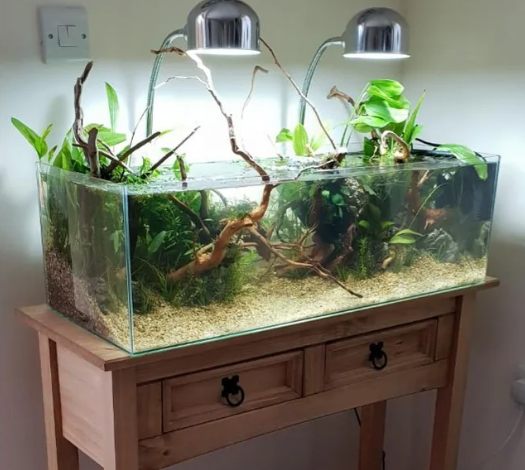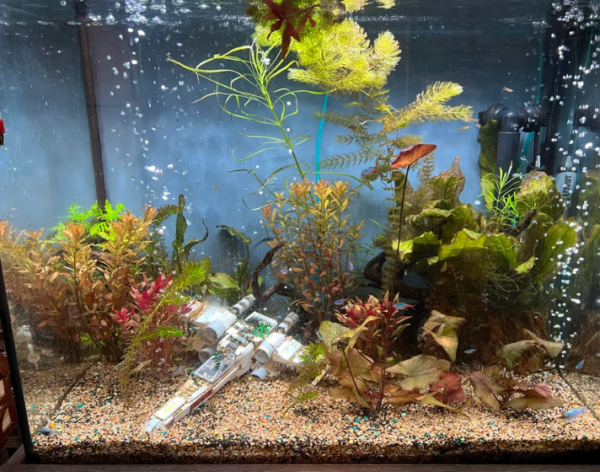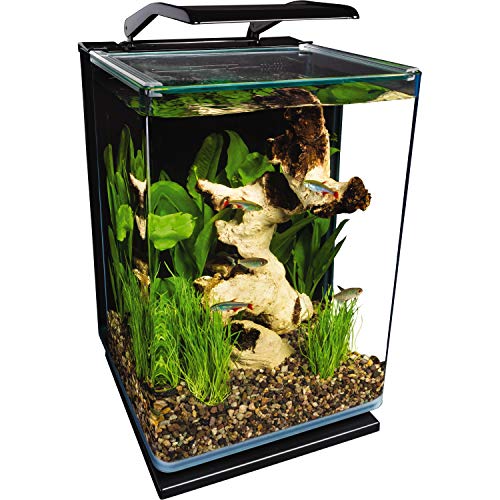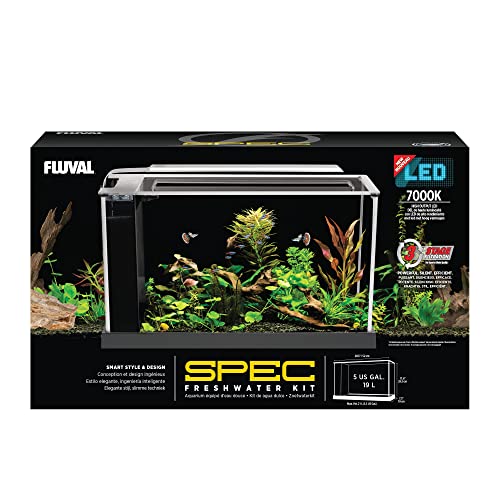[ad_1]
When we’re holding ourselves responsible for a certain number of lives, in our case—fish, it becomes critical to give them proper care, environment, and nutrition.
Maintaining a fish tank requires regular cleaning, water changes, and proper feeding, which may become challenging for interested yet inexperienced individuals.
For those, self-cleaning fish tanks are ideal. Although bigger ones may also support catfish and angels, these types of aquariums are specially made for beginner fish species like betta, molly, and guppies.
Hi, I’m Ushnish, a fish and snail enthusiast and professional breed, will be discussing self-cleaning tanks.
What Are Self-Cleaning Fish Tanks?
Complete self-cleaning tanks are a myth. All fish tanks require regular maintenance and cleaning to provide a healthy environment for your fish. Good-quality tanks, however, reduce the workload to a great extent.
Varying on the type, self-cleaning tanks automate a few aspects of maintenance, such as water change, lighting, and filtration.
Larger fish tanks (>20 gallons) of this category often come pre-installed with lighting and hidden filtration systems that are maintainable by replacing the filter cartridges. But, they often fail to match the standard of stand-alone filtration systems offered by canister and HOB filters.
In contrast, tiny tanks (Less than 5 gallons) often rely solely on gravity and automated water changes. Due to the absence of proper filtration and lighting, these self-cleaning tanks are only a chemical imbalance away from becoming a death trap for your fish.
How Does a Self-Cleaning Tank Work?

Let’s start with the purposes of filtration, lighting, and water changes in fish tanks.
An efficient biological and mechanical filtration system facilitates the nitrogen cycle and keeps your aquarium water free from ammonia, nitrite, and nitrate while giving it more clarity and aesthetics.
Adequate lighting keeps the plants alive in your tank and helps your fish feed, retain coloration, and maintain a sleep schedule. Reproduction is also influenced by lighting in many fish species.
The water in your tank consists of minerals and trace elements. The primary purposes of water change involve mineral replenishment, pH regulation, and toxin removal.
Different types of self-cleaning tanks work differently. Typically, 3 types of beginner self-cleaning tanks are found in the market that rely on different mechanisms for maintenance.
Gravity-Based
This type of self-cleaning tank employs gravity and water pressure for automated maintenance. Typically, an outlet hose is attached to the bottom of the tank to drain the organic debris and fish poop out of the system. The same drainage system is also used for water changes.
As no filtration mechanisms are installed in these fish tanks, regular and frequent water changes (at least 50% thrice a week) are essential to keep your fish alive. Moreover, in most cases, the air pump and adequate lighting also are excluded to keep the cost down and market it as “power efficient.”
Biological
A closed ecosystem is adapted in these kinds of self-cleaning fish tanks, where soil replacements, such as clay pellets, are used to grow plants above the aquarium. Underwater plants also are used frequently in this setup for respiration.
Typically much larger than gravity-based tanks, a water pump cycles the tank water through the clay pellets to exchange nutrients with the plants. The nitrite in the aquarium acts as fertilizer for the plants, and in exchange, the tank is relieved of toxins.
Mechanical
Similar to traditional fish tanks, mechanical self-cleaning tanks are generally much larger and empower themselves with appropriate filtration, lighting, and drainage systems. Reciprocally, they’re priced much higher than the rest.
While these also are considered self-cleaning fish tanks, you need to commit more efforts towards maintaining these aquariums with regular filter media changes, water changes, and quality tests. However, your piscine companions will shower you with gratitude for your benevolence!
How to Choose the Best Self-Cleaning Fish Tank?
First of all, disregard anything that doesn’t have enough horizontal swimming space. Fish bowls and tiny cylindrical tanks aren’t appropriate for any fish, including betta.

Let’s discuss a few elements that should contribute to your thought process while choosing the best self-cleaning fish tank.
Tank Size and Species
Goldfish, angelfish, betta, and guppies are the most common beginner fish species. You need to keep an eye out for their specific size and shape requirements.
For example, a minimum tank size of 5 gallons is essential to keep your betta healthy, while at least 10 gallons are optimum for a school of guppies. Anything below that can cause stress to your fish.
Goldfish, on the other hand, poop a lot and are messy eaters. The common goldfish require 20 gallons for a single fish, with 10 gallons for each additional one. Fancy varieties may require more to stay happy and healthy. Angelfish requires a similar tank volume but more horizontal swimming space.
Therefore, stay away from the 1-gallon tanks if you don’t want your fish to suffer and die within a month or two.
Filtration System
As discussed, our advice would be to steer clear of solely gravity-based self-cleaning fish tanks. While they can be used with frequent water changes and additional filtration, that negates the purpose of having an automated system.
Choose self-cleaning tanks that have dedicated mechanical and biological filtration systems (preferably hidden) to facilitate the nitrogen cycle and breakdown of toxins in the tank. Most premium products further minimize the workload by offering replaceable filter media cartridges.
If the biological self-cleaning tanks confuse you, recognize that the nitrogen exchange happening in the clay pellets, plants, and the tank is a natural filtration system. The beneficial bacteria growing in the pellets and substrate help disintegrate toxins in your aquarium and keep algae growth in check.
Water Change
As the objective of buying a self-cleaning fish tank is convenience, easy water changes should be a contributing factor. And as you need to frequently change the water, it’s an essential component for choosing the product.
Gravity-based systems ease the water change process to a great extent. Typically, they employ a drainage system that removes water from the tank with the fallen debris and poop. And as the outlet is located under the substrates, it doesn’t disturb the fish or the plants.
In biological and mechanical systems, manufacturers often include water-change valves to drain water through the in-built pump. If not, you need to manually siphon water out of the tank or use external pumps for the same.
Lighting
Consider adequate lighting when choosing your self-cleaning fish tank. Your planted aquarium would need more daylight than your shrimp tank. Aim for cool white lighting for your planted aquariums and warm blue lighting for your vibrant fish buddies.
Energy Efficiency
The filtration system, lighting, and pump cost energy to run throughout the day. While a single tank may not significantly influence your energy bill, multiple of these setups may make a dent in your pocket.
Efficient filter media, adjustable flow rate, and energy-efficient lighting can help you bring the costs down and reduce wastage. If filtration and lighting systems aren’t provided, get energy-efficient equipment from external sources that last longer and meet your expectations.
When buying from third-party manufacturers, ensure that the accessories are compatible with the particular product you have. Filtration systems, for instance, can put stress on the fish with an unnecessarily high flow rate.
Price
The price of self-cleaning fish tanks ranges between a few and a few hundred dollars. With growing features, size, and efficiency, the prices go higher. Two tanks of the same size may vastly differ in price if one of them offers a smart lighting system and the other fails to even provide one.
Similar pricing differentials may also be noticed with better filtration systems, better substrate choices, and more decorations.
The build quality of the aquariums also plays a huge role in the determination of pricing.
Reviews
Before choosing your self-cleaning tank, go through the reviews on their website and Amazon to understand how reliable the product is. Negative reviews often disclose the lacking of the systems and the absence of features that are critical to you.
Video reviews on YouTube and the websites also are reliable trust signals that you may leverage to choose the best self-cleaning fish tank.
Benefits of Self-Cleaning Fish Tank

The benefits associated with self-cleaning fish tanks are:
Less maintenance
Any variety of self-cleaning tanks requires less maintenance than traditional fish tanks. If nothing, unplugging electricals and conjunctions, and siphoning can take twice the time it takes to maintain a self-cleaning fish tank.
If you’re stressing over water changes, most of these aquariums offer convenient ways to drain water out of the system. For larger aquariums, a pump and automatic siphon should work.
In the case of pre-installed filters, most of them come with replaceable cartridge systems to minimize the footprint. Whereas, dedicated filtration systems would require you to replace the media when necessary.
More convenient
Self-cleaning tanks are more convenient to transport and maintain. Smaller tanks also make great gifts for your children. As very little to no instructions are needed, self-cleaning tanks are more convenient than traditional aquariums.
Moreover, the absence of glass panels in most self-cleaning fish tanks allows these tanks to be much lighter and easier to move around. Acrylic panels also are easier to bend and give specific shapes for aesthetic purposes.
However, although acrylic panels appear similar, they lack the integrity and strength of glass.
Drawbacks of Self-Cleaning Fish Tank
Despite offering massive benefits, self-cleaning fish tanks aren’t without their drawbacks. Here are a few drawbacks that you should consider before getting one:
Smaller than the required size
Except for the high-end products, most self-cleaning fish tanks are smaller than required, even for the tiniest of the habitants. For example, fish species like Ember Tetra, Galaxy Rasbora, and Pygmy Corydoras may be small, but they require horizontal swimming space to dart.
The misconception revolving around small fish species requiring smaller swimming space opens up the opportunity for these manufacturers to produce a prison and sell them at a premium price.
Faster toxin buildup
Due to a lack of adequate filtration, toxins build up faster in most of these aquariums. In addition, the acrylic used in the cheaper self-cleaning tanks may react with the ammonia or cleaning agents to influence the water parameters and health of the fish.
Additionally, the space limitations also decelerate dilution and promote toxin buildup in smaller tanks. If your fish has a higher bioload, which means if they eat and poop too much, consider avoiding the self-cleaning tanks.
Unstable water parameters
Again, as a result of lack of space and proper nitrogen cycle, local water parameter changes can suddenly scale to affect the whole tank. This triggers a chain reaction.
As a fight or flight response, blood glucose levels in your fish increase—giving them an energy boost for a short span.
Their inflammatory response, designed to fight diseases, is suppressed to designate more energy to get away from the toxins.
Water balance and osmoregulation in their body are disrupted–causing respiration increase, an increase in blood pressure, and other metabolic changes.
Furthermore, you won’t be able to notice their discomfort before their energy levels are depleted. Your fish may seem fine for a few days before contracting a disease or dying of heart failure.
Lack of oxygen
Due to the small size of the tanks, not enough oxygen can be dissolved into the water for the fish to survive. And tiny self-cleaning tanks can’t accommodate water pumps or filters to create water movement for oxygen replenishment.
If you already have those tanks and have no means to move the fish to a bigger tank, at least try to arrange for a water pump for the fish to survive. Limit the flow rate to not cause stress to your fish.
Best Self-Cleaning Fish Tanks
With the benefits and our experience with them in mind, here are a few self-cleaning tanks that we find to be the best.
1. Marineland Portrait Glass LED Aquarium Kit
Focusing on vertical swimming and multiple viewing angles, the Marineland Portrait Glass Aquarium is a perfect choice for a few plants and a betta. Its sleek design makes it perfect for kitchen countertops and birthday gifts. The kit also is beginner-friendly and easy to assemble.
Features:
- Rounded corners and clear sliding glass canopy
To make it safe for proximal use and child-safe, this self-cleaning fish tank comes with rounded corners and a sliding glass canopy—allowing a broader viewing angle.
- Daylight/Moonlight lighting
Bright white LEDs, paired with blue LEDs, create a dreamy daylight/moonlight lighting effect that enhances the greens of plants and the vibrancy of your fish.
Complying with the minimum requirement of keeping a betta or a school of small fish, this self-cleaning setup is great for inexperienced enthusiasts.
- Hidden 3-stage filtration
Powered by Rite-Size Z Cartridge and Marineland Bio-Foam, the 3-stage filtration of this setup lets you enjoy the activities of your fish without needing to spend hours maintaining the tank.
Pros:
- Perfect fit for live plants with a betta
- Great pricing
- Easy to set up.
- Adjustable pumps to reduce water flow
Cons:
- Light too dim for planted tanks
- Small horizontal space
Summary: Marineland Portrait Glass LED Aquarium Kit is the best betta self-cleaning tank for beginners.
2. Fluval SPEC Aquarium Kit
A common name in the fishkeeping community, the Fluval SPEC aquarium kit is a small yet efficient freshwater self-cleaning tank. Designed to house guppies and a few small active fish with plants, this model comes with adequate filtration and lighting. This kit also is beginner-friendly and easy to assemble.
Features:
Consisting of 37 LEDs with 7000K cool daylight color temperature and 821 lumens, this self-cleaning setup is critical for planted aquariums with vibrant fish.
- Etched glass construction with aluminum trim
Giving a modern appearance, this full glass fish tank, with etched sides and aluminum trims covering the corners, is complete by the beehive design of the filtration system.
- 3-stage premium filtration system
Proprietary products from Fluval, including foam block, activated carbon, and BioMax Bio rings, are used to create the 3-stage filtration system for this 5-gallon self-cleaning fish tank.
Pros:
- Low noise level. Doesn’t make rattling or whooshing sounds.
- Appropriate pricing.
- Horizontal swimming space to support the active swimming fish species.
- Adequate filtration and pump flow.
Cons:
- Filter suction is a bit on the higher side. If not careful, it can suck small fish and shrimp into it.
Summary: Fluval SPEC Aquarium Kit is the best self-cleaning fish tank for active swimmer small fish species.
3. Tetra ColorFusion Aquarium 20 Gallon Fish Tank
Perfect for beginner aquarists, the Tetra ColorFusion equips itself with a UL heater, filtration system, and color-changing LEDs. The large self-cleaning fish tank is suitable for small to medium fish species, such as Dwarf Gourami, Angelfish, Goldfish, and Mollies. The tank also comes bundled with all essential accessories and is easy to set up.
Features:
- Multi-color ColorFusion LED lights
The Colorfusion Universal Color Changing LED cycles between colors to allow you to customize the self-cleaning fish tank as you prefer. The tetra plants and anemones glow with the flow of water and bright daylight lighting.
A blooming white anemone is included with the package to decorate your aquarium and give your fish space to hide and play around. The filter outlet is powerful enough to sway the anemones.
- Heater, Filtration, and plants included
Just get the fish, gravels, fish food, and water conditioners to start your self-cleaning fish tank. The rest, including the heater, filter, and plants, are already bundled with the package.
You won’t need to worry about tank size with this setup as long as you’re not overstocking. The large 20-gallon aquarium provides both vertical and horizontal swimming space for your fish.
Pros:
- Easy to assemble
- All-inclusive package
- Adequate pricing, considering the accessories included
- Both horizontal and vertical swimming space
Cons:
- A bit noisy water filter pump
- Build quality could’ve been better
Summary: Tetra ColorFusion Aquarium 20 Gallon Fish Tank is best for beginner aquarists with a bigger tank requirement.
The Bottom Line
Self-cleaning fish tanks are great for beginner aquarium enthusiasts with limited knowledge and time. Although you still need to maintain the aquarium, the workload is significantly lower than traditional setups. Choose tanks that come in-built with mechanical and biological filtration systems and have adequate swimming space for your preferred fish.
[ad_2]
Source link



